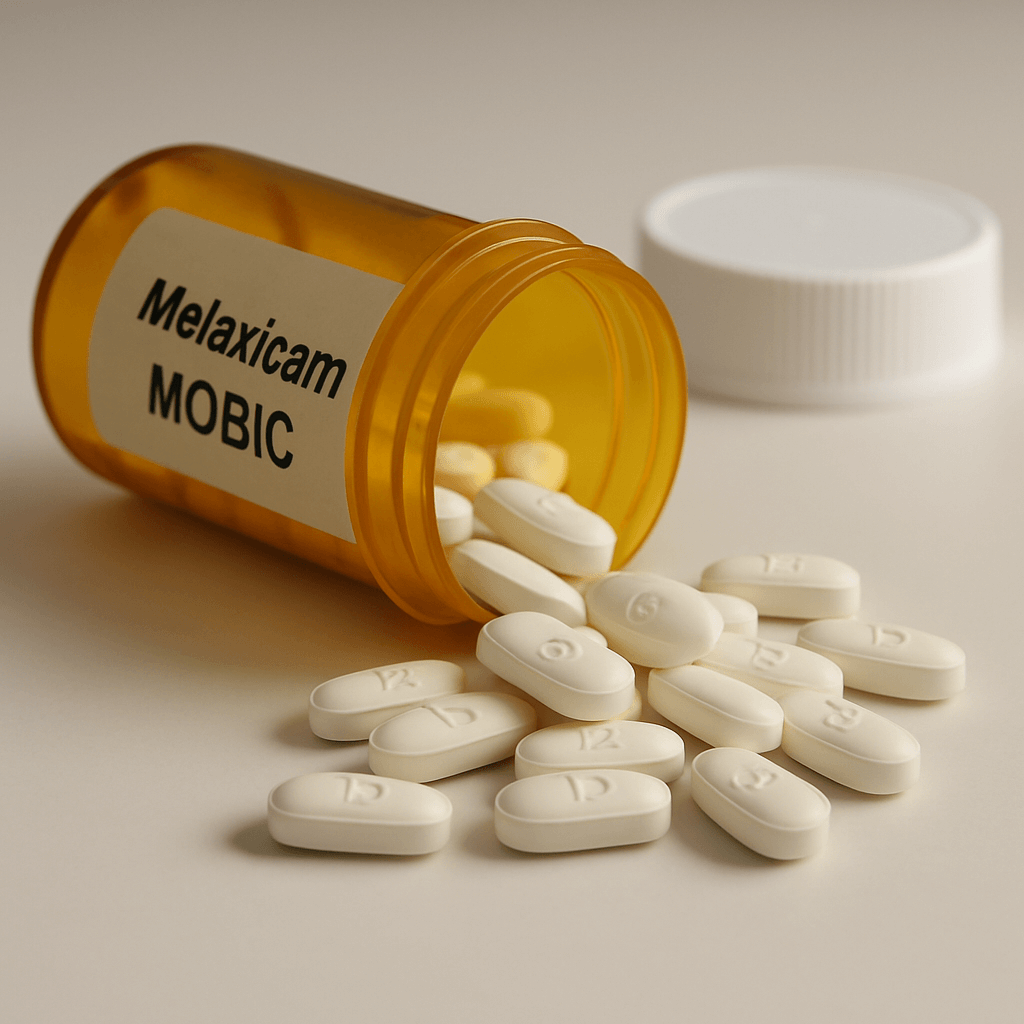Last Updated on November 24, 2025
How Strong Is Meloxicam Compared With Other NSAIDs?
Meloxicam is a prescription nonsteroidal anti-inflammatory drug (NSAID) that doctors prescribe for osteoarthritis, rheumatoid arthritis, and juvenile idiopathic arthritis. It’s usually taken once daily. Pharmacologists describe meloxicam as “preferential” for the COX-2 enzyme. That means it targets inflammation while still sharing the class risks of other NSAIDs.
Because meloxicam is prescription-only and long acting, many people assume it must be one of the strongest NSAIDs. Clinical trials tell a more nuanced story. In multiple head-to-head studies, meloxicam provided pain relief similar to several older nonselective NSAIDs. One large review even found slightly smaller improvements in pain compared with some traditional agents, although the differences were modest.
If you want a deeper dive into how this medication works, our detailed guide on meloxicam (Mobic) uses and risks explains its dosing, side effects, and safety warnings.
Meloxicam vs. ibuprofen and naproxen
Ibuprofen and naproxen are familiar over-the-counter NSAIDs. At usual prescription doses, meloxicam tends to last longer, so many people only need one dose per day. Ibuprofen and naproxen often require dosing several times daily, even though they may offer similar overall pain relief.
From a safety perspective, the picture is mixed. Several large analyses suggest that naproxen and low-dose ibuprofen raise cardiovascular (heart and blood vessel) risk less than many other NSAIDs. Meloxicam appears somewhere in the middle: not the riskiest, but not clearly the safest either.
Where meloxicam fits on the “strength” spectrum
Research that compares many NSAIDs at equivalent doses suggests a pattern. Diclofenac at 150 mg per day may provide the best average improvement in osteoarthritis pain and function, with meloxicam, naproxen, and ibuprofen close behind. So meloxicam is certainly a strong NSAID, but it’s not uniquely powerful. For most people, it sits in the “moderately strong and convenient” category rather than at the absolute top of the potency scale.
Meloxicam Dangers and Risks You Should Understand
Before looking for meloxicam stronger medication options, it’s worth understanding the meloxicam dangers that already exist. Like all NSAIDs, meloxicam can cause serious side effects, especially at higher doses, with long-term use, or in people with other medical problems.
Gastrointestinal and cardiovascular risks of meloxicam
According to the U.S. National Library of Medicine’s MedlinePlus drug information, NSAIDs such as meloxicam may cause ulcers, bleeding, or even holes in the stomach or intestines. These injuries sometimes develop without warning symptoms. These complications can be life-threatening. The risk is higher for older adults, those with a history of ulcers or bleeding, and people who drink heavily while on the drug.
Meloxicam also carries cardiovascular risks. Large safety reviews of NSAIDs show that many drugs in this class increase the risk of heart attacks, strokes, and heart failure. One population-based study found that people taking meloxicam had about a 38% higher risk of myocardial infarction, or heart attack, compared with non-users.
Other meloxicam side effects and special situations
Other meloxicam risks include kidney injury, fluid retention, and increased blood pressure. These problems are more likely if you already have kidney or heart disease, take diuretics or blood pressure medications, or become dehydrated.
Pregnancy is another critical consideration. Clinical guidance warns that NSAIDs such as meloxicam should generally be avoided from around 20 weeks of pregnancy onward because of potential fetal kidney and amniotic fluid problems. The concerns grow even stronger in the third trimester because NSAIDs can affect the fetal heart.
Finally, combining meloxicam with alcohol or other drugs creates additional dangers. Mixing meloxicam with alcohol amplifies the risk of stomach bleeding and liver stress. Pairing it with other NSAIDs, steroids, anticoagulants, SSRIs or SNRIs, or certain blood pressure medications can also raise the chance of serious side effects.
Because the drug is often used long term, it’s essential to review these meloxicam dangers with your prescriber from time to time instead of assuming the medication is low-risk.
Meloxicam vs. Stronger NSAIDs: When Might a Different Anti-Inflammatory Be Used?
People sometimes ask about “meloxicam stronger alternatives” when their current dose doesn’t seem to control pain, or when they read that other NSAIDs might work better. In practice, doctors weigh both effectiveness and safety, not just raw strength.
Comparative studies and evidence summaries suggest several key points about meloxicam vs stronger NSAIDs.
- Diclofenac: At 150 mg per day, diclofenac often ranks as one of the most effective NSAIDs for osteoarthritis pain and function. However, research links this drug to a higher relative risk of cardiovascular events than some other agents, particularly naproxen.
- Naproxen: Naproxen may be slightly less potent than diclofenac at maximum doses, but many analyses suggest it carries a lower cardiovascular risk. Because of this, clinicians often choose naproxen when heart risk is a major concern.
- High-dose ibuprofen: Prescription-strength ibuprofen can provide pain relief similar to meloxicam in some settings. Higher doses, however, may raise gastrointestinal and kidney risks, particularly when you combine ibuprofen with other medications.
- COX-2–selective drugs (for example, celecoxib): COX-2–selective drugs target COX-2 more than COX-1 and may reduce ulcer risk. Several studies still show significant cardiovascular risks, so clinicians must weigh benefits and harms carefully.
To put these options in context, clinical resources compile comparative NSAID dosing tables. These tables show equivalent dose ranges for pain relief across different drugs. The key takeaway is simple: there is no single “best” or “strongest” NSAID for everyone. A drug that seems stronger than meloxicam on paper may carry a higher risk for your particular heart, stomach, or kidney history.
Because of these trade-offs, you should only switch from meloxicam to a “stronger” NSAID under medical supervision. Never stack multiple NSAIDs or increase doses on your own.
Stronger Medication Options Beyond Meloxicam
Sometimes the issue is not meloxicam versus stronger NSAIDs at all. NSAIDs in general may not provide enough relief, or their risks may outweigh their benefits. In those cases, clinicians may look at non-NSAID pain relievers or, in selected situations, opioid medications.
Non-NSAID options that may help
Several non-NSAID options can sometimes provide “stronger” relief for specific people or conditions without immediately jumping to opioids:
- Acetaminophen (paracetamol): Clinicians often recommend acetaminophen for mililder pain or for people who cannot take NSAIDs. It does not reduce inflammation but can help with pain perception. Overuse can damage the liver, so dosing limits are crucial.
- Topical NSAIDs: Gels or creams containing diclofenac and similar drugs can deliver high local concentrations to painful joints with lower blood levels. This approach may reduce systemic risk. Reviews of osteoarthritis treatments indicate that topical diclofenac can be highly effective for knee and hand pain and may outperform oral acetaminophen with fewer systemic side effects.
- Nerve pain medications: Certain antidepressants or anticonvulsants may help when pain is neuropathic (nerve-based) rather than inflammatory. These medicines target the way nerves send pain signals to the brain.
- Injections and procedures: Corticosteroid injections, joint viscosupplementation, or nerve blocks are sometimes used for targeted, short-term relief when oral drugs are not enough.
Opioid painkillers: powerful but high risk
The phrase “meloxicam stronger medication options” often points toward opioid drugs like hydrocodone, oxycodone, morphine, or extended-release formulations used for severe pain. These medications can provide powerful relief but come with major risks: tolerance, dependence, overdose, and addiction.
Research comparing NSAIDs and opioids for osteoarthritis shows that, in many cases, oral NSAIDs provide similar pain reduction to opioids. Opioids carry a much higher burden of side effects and long-term harms. That’s one reason current guidelines urge clinicians to maximize non-opioid therapies first and use opioids only when benefits clearly outweigh risks, at the lowest effective dose and for the shortest possible time.
Our in-depth article on oxycodone and its addiction risks explains how quickly a short-term pain prescription can turn into a serious opioid use disorder that requires professional treatment.
If you live with chronic pain and also have a history of substance use, the risks of moving from meloxicam to opioids are even higher. In these situations, a pain specialist and addiction-informed provider can help design a plan that balances pain relief with relapse prevention.
How to Talk With Your Doctor About Meloxicam Stronger Alternatives
Whether meloxicam is underperforming or causing side effects, you should start with a clear conversation with your prescriber. This step matters more than any do-it-yourself experiment.
Before your visit, it helps to think through a few questions:
- What exactly is not working? Is the pain constant, or does it flair at certain times of day or with specific activities?
- Have you given meloxicam enough time? For chronic arthritis, it may take several days to reach full effect, and changes in dose should be gradual.
- Are you taking it correctly? Many people do not realize that doubling up with over-the-counter NSAIDs or drinking alcohol regularly turns routine use into a high-risk pattern.
- What are your medical risks? A history of ulcers, bleeding, heart disease, kidney problems, or pregnancy can change which pain relievers are safest for you.
During the appointment, your provider may discuss options such as trying another NSAID with a different risk profile or adding topical treatments or physical therapy. In some cases, they may consider a carefully monitored opioid regimen. They may also suggest non-drug strategies like exercise therapy, weight management, heat or cold therapy, and cognitive-behavioral approaches to pain.
If you are worried about opioids but still need better relief, our article on meloxicam as a safer alternative to opioid painkillers explores how non-opioid medications can support pain control while reducing addiction risk.
Whatever you decide, never stop or start prescription medications without medical guidance, and never combine multiple NSAIDs unless your clinician explicitly recommends it.
When Pain Medication Use Turns Into a Bigger Problem
Meloxicam itself is not an opioid and is not known to cause euphoria. Still, pain management and addiction risk often overlap. People who are desperate for relief may start taking higher doses than recommended, mix meloxicam with alcohol, or add opioids or sedatives on their own. Over time, this pattern can become just as dangerous as an outright opioid problem.
Warning signs that your pain medication use—whether NSAIDs, opioids, or both—may be getting out of control include:
- Taking more pills or more frequent doses than your doctor recommended.
- Using medication to cope with stress, sleep, or emotions rather than just pain.
- Mixing meloxicam with alcohol, sedatives, or illicit drugs despite knowing the risks.
- Seeing multiple prescribers or pharmacies to maintain your supply.
- Feeling unable to cut back even when health problems, finances, or relationships are suffering.
When pain medication misuse starts affecting daily life, a structured recovery setting can make a significant difference. Our inpatient rehab center in Wimberley, TX helps individuals stabilize physically and emotionally while building long-term recovery skills.
If any of this sounds familiar, you are not alone—and you are not “weak” for needing help. Nova Recovery Center specializes in supporting people whose pain treatment has collided with substance use problems, whether that involves opioids, alcohol, or other drugs. Comprehensive care can include medically supervised detox, residential treatment, outpatient support, and long-term recovery planning tailored to your situation.
Reaching out for help does not mean your pain will be ignored. It means building a safer, more sustainable plan for both pain and recovery.















